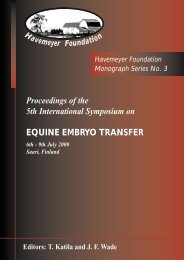Proceedings of a Workshop on - The Havemeyer Foundation
Proceedings of a Workshop on - The Havemeyer Foundation
Proceedings of a Workshop on - The Havemeyer Foundation
You also want an ePaper? Increase the reach of your titles
YUMPU automatically turns print PDFs into web optimized ePapers that Google loves.
Equine Recurrent Laryngeal Neuropathy<br />
reference to pituitary adenomas in 2 p<strong>on</strong>ies with<br />
liver failure and inspiratory dyspnoea, which were<br />
subjected to detailed post mortem examinati<strong>on</strong>.<br />
Rarely, horses may develop post operative<br />
laryngeal paralysis, sometimes complicated by<br />
sec<strong>on</strong>dary severe pulm<strong>on</strong>ary oedema and/or<br />
haemorrhage (Abrahamsen et al. 1990; Dix<strong>on</strong> et<br />
al. 1993, 2001). <strong>The</strong>se cases had variable recovery<br />
<str<strong>on</strong>g>of</str<strong>on</strong>g> laryngeal functi<strong>on</strong>, with <strong>on</strong>e horse showing<br />
complete resoluti<strong>on</strong> within 24 h, while another had<br />
residual laryngeal dysfuncti<strong>on</strong> after <strong>on</strong>e year.<br />
Post-operative laryngeal paralysis was most likely<br />
to have resulted from excessive head/neck<br />
extensi<strong>on</strong>, which could induce neural stretch<br />
injury or cause neural hypoxia via occlusi<strong>on</strong> <str<strong>on</strong>g>of</str<strong>on</strong>g> the<br />
vasa nervorum. Alternatively, laryngeal paralysis<br />
may have resulted from compressi<strong>on</strong> <str<strong>on</strong>g>of</str<strong>on</strong>g> the<br />
recurrent laryngeal nerve against a rigid structure<br />
in the neck. Myopathy, persistent hypoxia and preexisting<br />
laryngeal dysfuncti<strong>on</strong> are additi<strong>on</strong>al<br />
factors that may c<strong>on</strong>tribute to development <str<strong>on</strong>g>of</str<strong>on</strong>g> this<br />
complicati<strong>on</strong>. Temporary post operative laryngeal<br />
paralysis has also been reported in a dog.<br />
A variety <str<strong>on</strong>g>of</str<strong>on</strong>g> toxic peripheral neuropathies may<br />
cause equine laryngeal paralysis including delayed<br />
organophosphate induced toxicity, Australian<br />
stringhalt, lead pois<strong>on</strong>ing and plant pois<strong>on</strong>ing.<br />
However in all such cases, laryngeal paralysis is<br />
clearly part <str<strong>on</strong>g>of</str<strong>on</strong>g> generalised disorder that affects<br />
multiple nerves, and so presents little diagnostic<br />
problem. Delayed organophosphate induced<br />
toxicity leads predominantly to degenerati<strong>on</strong> <str<strong>on</strong>g>of</str<strong>on</strong>g><br />
l<strong>on</strong>g ax<strong>on</strong>s in peripheral nerves and spinal cord, and<br />
results from covalent binding <str<strong>on</strong>g>of</str<strong>on</strong>g> organophosphates<br />
to ‘neuropathy target esterase’. Organophosphate<br />
induced laryngeal paralysis may be permanent<br />
(Rose et al. 1981; Duncan and Brook 1985).<br />
Ingesti<strong>on</strong> <str<strong>on</strong>g>of</str<strong>on</strong>g> Lathyrus spp. and Cicer arietinum<br />
(chick pea) may cause equine laryngeal paralysis.<br />
<strong>The</strong> toxic principles include beta-N- oxalylamino-<br />
L-alanine, an excitatory amino acid which causes<br />
neuropathy with distal ax<strong>on</strong>al degenerati<strong>on</strong>.<br />
Feeding experiments with Lathyrus sativus (Indian<br />
vetch) indicated that, even with prol<strong>on</strong>ged feeding,<br />
<strong>on</strong>ly a minority <str<strong>on</strong>g>of</str<strong>on</strong>g> horses were affected. Lead<br />
toxicosis primarily targets peripheral nerves, and<br />
approximately 13% <str<strong>on</strong>g>of</str<strong>on</strong>g> horses with lead toxicosis<br />
develop laryngeal dysfuncti<strong>on</strong> (Sojka et al. 1996),<br />
which may or may not recover with time. <strong>The</strong><br />
pathogenesis <str<strong>on</strong>g>of</str<strong>on</strong>g> lead neurotoxicosis is multifactorial<br />
and includes inactivati<strong>on</strong> <str<strong>on</strong>g>of</str<strong>on</strong>g> thiol and<br />
cysteine-c<strong>on</strong>taining enzymes, and Zn-, Cu-, Fedependent<br />
enzymes, resulting in neural oxidative<br />
stress, and toxicity <str<strong>on</strong>g>of</str<strong>on</strong>g> cell membranes resulting in<br />
increased membrane permeability.<br />
Hyperkalaemic periodic paresis, a generalised<br />
myasthenic disorder, comm<strong>on</strong>ly presents with<br />
episodic upper airway obstructi<strong>on</strong>. While airway<br />
obstructi<strong>on</strong> in this disorder is multi-factorial,<br />
laryngeal spasm or paralysis occurs in<br />
approximately half <str<strong>on</strong>g>of</str<strong>on</strong>g> affected horses. <strong>The</strong> severity<br />
and incidence <str<strong>on</strong>g>of</str<strong>on</strong>g> upper airway dysfuncti<strong>on</strong> may be<br />
reduced by medical treatment (Carr et al. 1996).<br />
REFERENCES<br />
Abrahamsen, E.J., B<strong>on</strong>ah<strong>on</strong>, T.C., Bednarski,<br />
R.M., Hubbell, J.A.E., and Muir, W.W. (1990)<br />
Bilateral arytenoid cartilage paralysis after<br />
inhalati<strong>on</strong> anaesthesia in a horse. J. Am. vet. med.<br />
Ass. 197, 1363-1365.<br />
Carr, E.A., Spier, S.J., Kortz, G.D., and H<str<strong>on</strong>g>of</str<strong>on</strong>g>fman, E.P.<br />
(1996) Laryngeal and pharyngeal dysfuncti<strong>on</strong> in<br />
horses homozygous for hyperkalemic periodic<br />
paralysis. J. Am. vet. med. Ass. 209, 798-803.<br />
Cooper, R.A. and Huxtable, R.J. (1999) <strong>The</strong> relati<strong>on</strong>ship<br />
between reactivity <str<strong>on</strong>g>of</str<strong>on</strong>g> metabolites <str<strong>on</strong>g>of</str<strong>on</strong>g> pyrrolizidine<br />
alkaloids and extrahepatic toxicity. Proc. West<br />
Pharmacol. Soc. 42, 13-16.<br />
Dix<strong>on</strong>, P.M., Railt<strong>on</strong>, D.I., and McGorum, B.C. (1993)<br />
Temporary bilateral laryngeal paralysis in a horse<br />
associated with general-anaesthesia and post<br />
anesthetic myositis. Vet. Rec. 132, 29-32.<br />
Dix<strong>on</strong>, P.M., McGorum, B.C., Railt<strong>on</strong>, D.I., Hawe, C.,<br />
Tremaine, W.H., Pickles, K., and McCann, J. (2001)<br />
Laryngeal paralysis: a study <str<strong>on</strong>g>of</str<strong>on</strong>g> 375 cases in a<br />
mixed-breed populati<strong>on</strong> <str<strong>on</strong>g>of</str<strong>on</strong>g> horses. Equine vet. J. 33,<br />
452-458.<br />
Duncan, I.D. and Brook, D. (1985) Bilateral laryngeal<br />
paralysis in the horse. Equine vet. J. 17, 228-233.<br />
Goulden, B.E. and Anders<strong>on</strong>, L.J. (1981) Equine<br />
laryngeal hemiplegia part II: some clinical<br />
observati<strong>on</strong>s. N. Z. vet. J, 29, 194-198.<br />
Mayhew, I.G. (1989) Large Animal Neurology. Lea and<br />
Febiger, L<strong>on</strong>d<strong>on</strong>.<br />
McGorum, B.C., Murphy, D., Love, S., and Milne, E.M.<br />
(1999) Clinicopathological features <str<strong>on</strong>g>of</str<strong>on</strong>g> equine<br />
primary hepatic disease: a review <str<strong>on</strong>g>of</str<strong>on</strong>g> 50 cases. Vet.<br />
Rec. 145, 134-139.<br />
Pears<strong>on</strong>, E.G. (1991) Liver failure attributable to<br />
pyrrolizidine alkaloid toxicity and associated with<br />
inspiratory dyspnea in p<strong>on</strong>ies: Three cases (1982-<br />
1988). J. Am. vet. med. Ass. 9, 1651-1654.<br />
Rose, R.J., Hartley, W.J., and Baker, W. (1981)<br />
Laryngeal paralysis in Arabian foals associated with<br />
oral halox<strong>on</strong> administrati<strong>on</strong>. Equine vet. J. 13, 171-<br />
176.<br />
Sojka, J.E., Hope, W., and Pears<strong>on</strong>, D. (1996) Lead<br />
toxicosis in 2 horses: similarity to equine<br />
degenerative lower motor neur<strong>on</strong> disease. JVIM 10,<br />
420-423.<br />
56








